Characteristics and Source Apportionment of Metallic Elements in PM2.5 at Urban and Suburban Sites in Beijing: Implication of Emission Reduction
Abstract
:1. Introduction
2. Materials and Methods
2.1. Sites and Sampling
2.2. Chemical Analysis
2.3. Data Analysis
2.3.1. Enrichment Factor (EF)
2.3.2. Positive Matrix Factorization (PMF)
3. Results and Discussion
3.1. PM2.5 Mass Concentration and Meteorological Conditions
3.2. Concentrations of Metallic Elements
3.3. Day/Night Variations in Metallic Elements
3.4. Characteristics of Metallic Elements under Different Pollution Levels
3.5. Source Apportionment of Metallic Elements
4. Conclusions
Supplementary Materials
Author Contributions
Funding
Acknowledgments
Conflicts of Interest
References
- Dockery, D.W.; Pope, C.A.; Xu, X.; Spengler, J.D.; Ware, J.H.; Fay, M.E.; Ferris, B.G., Jr.; Speizer, F.E. An association between air pollution and mortality in six U.S. cities. New England J. Med. 1993, 329, 1753–1759. [Google Scholar] [CrossRef] [PubMed]
- Rd, P.C.; Dockery, D.W. Health effects of fine particulate air pollution: Lines that connect. J. Air Waste Manage. Assoc. 2006, 56, 709–742. [Google Scholar]
- Wang, J.L.; Zhang, Y.H.; Shao, M.; Liu, X.L.; Zeng, L.M.; Cheng, C.L.; Xu, X.F. Quantitative relationship between visibility and mass concentration of PM2.5 in Beijing. J. Environ. Sci. 2006, 18, 475–481. [Google Scholar]
- Chow, J.C.; Watson, J.G.; Fujita, E.M.; Lu, Z.; Lawson, D.R.; Ashbaugh, L.L. Temporal and spatial variations of PM2.5 and PM10 aerosol in the southern California air quality study. Atmos Environ. 1994, 28, 2061–2080. [Google Scholar] [CrossRef]
- Donaldson, K.; Brown, D.; Clouter, A.; Duffin, R.; Macnee, W.; Renwick, L.; Tran, L.; Stone, V. The pulmonary toxicology of ultrafine particles. J. Aerosol Med. 2002, 15, 213–220. [Google Scholar] [CrossRef] [PubMed]
- Prahalad, A.K.; Soukup, J.M.; Inmon, J.; Willis, R.; Ghio, A.J.; Becker, S.; Gallagher, J.E. Ambient air particles: Effects on cellular oxidant radical generation in relation to particulate elemental chemistry. Toxicol. Appl. Pharmacol. 1999, 158, 81–91. [Google Scholar] [CrossRef] [PubMed]
- Gao, Y.; Nelson, E.D.; Field, M.P.; Ding, Q.; Li, H.; Sherrell, R.M.; Gigliotti, C.L.; Van Ry, D.A.; Glenn, T.R.; Eisenreich, S.J. Characterization of atmospheric trace elements on PM2.5 particulate matter over the New York–New Jersey harbor estuary. Atoms. Environ. 2002, 36, 1077–1086. [Google Scholar] [CrossRef]
- Pan, Y.P.; Wang, Y.S. Atmospheric wet and dry deposition of trace elements at 10 sites in Northern China. Atmos. Chem. Phys. 2015, 15, 951–972. [Google Scholar] [CrossRef]
- Chen, Z.; Zhang, J.; Zhang, T.; Liu, W.; Liu, J. Haze observations by simultaneous lidar and WPS in Beijing before and during APEC, 2014. Sci. China Chem. 2015, 58, 1385–1392. [Google Scholar] [CrossRef]
- Sheng, L.; Lu, K.; Ma, X.; Hu, J.K.; Song, Z.X.; Huang, S.X.; Zhang, J.P. The air quality of Beijing-Tianjin-Hebei regions around the Asia-Pacific Economic Cooperation (APEC) meetings. Atmos. Pollut. Res. 2015, 6, 1066–1072. [Google Scholar] [CrossRef]
- Tang, G.; Zhu, X.; Hu, B.; Xin, J.; Wang, L.; Münkel, C.; Mao, G.; Wang, Y. Impact of emission controls on air quality in Beijing during APEC 2014: Lidar ceilometer observations. Atoms. Chem. Phys. 2015, 15, 12667–12680. [Google Scholar] [CrossRef]
- Wen, W.; Cheng, S.; Chen, X.; Wang, G.; Li, S.; Wang, X.; Li, S.; Wang, X.; Liu, X. Impact of emission control on PM2.5 and the chemical composition change in Beijing-Tianjin-Hebei during the APEC summit 2014. Environ. Sci. Pollut. Res. 2016, 23, 4509–4521. [Google Scholar] [CrossRef] [PubMed]
- Liu, Z.; Hu, B.; Zhang, J.; Xin, J.; Wu, F.; Gao, W.; Wang, M.; Wang, Y. Characterization of fine particles during the 2014 Asia-Pacific economic cooperation summit: Number concentration, size distribution and sources. Tellus B Chem Phys. Meteor. 2017, 69. [Google Scholar] [CrossRef]
- Wang, Y.; Zhang, Y.; Schauer, J.J.; De, F.B.; Guo, B.; Zhang, Y. Relative impact of emissions controls and meteorology on air pollution mitigation associated with the Asia-Pacific Economic Cooperation (APEC) conference in Beijing, China. Sci. Total Environ. 2016, 571, 1467–1476. [Google Scholar] [CrossRef] [PubMed]
- Chang, Y.; Liu, X.; Deng, C.; Dore, A.J.; Zhuang, G. Source apportionment of atmospheric ammonia before, during, and after the 2014 APEC summit in Beijing using stable nitrogen isotope signatures. Atmos. Chem. Phys. 2016, 16, 1–26. [Google Scholar] [CrossRef]
- Liacos, J.W.; Kam, W.; Delfino, R.J.; Schauer, J.J.; Sioutas, C. Characterization of organic, metal and trace element PM2.5 species and derivation of freeway-based emission rates in Los Angeles, CA. Sci. Total. Environ. 2012, 435–436, 159–166. [Google Scholar] [CrossRef] [PubMed]
- Yatkin, S.; Bayram, A. Source apportionment of PM10 and PM2.5 using positive matrix factorization and chemical mass balance in Izmir, Turkey. Sci. Total Environ. 2008, 390, 109–123. [Google Scholar] [CrossRef] [PubMed]
- Song, Y.; Tang, X.Y.; Xie, S.D.; Zhang, Y.H.; Wei, Y.J.; Zhang, M.S.; Zeng, L.; Lu, S. Source apportionment of PM2.5 in Beijing in 2004. J. Hazard. Mater. 2007, 146, 124–130. [Google Scholar] [CrossRef] [PubMed]
- Liu, Z.; Gao, W.; Yu, Y.; Hu, B.; Xin, J.; Sun, Y.; Wang, L.; Wang, G.; Bi, X.; Zhang, G.; et al. Characteristics of PM2.5 mass concentrations and chemical species in urban and background areas of China: Emerging results from the CARE-China network. Atmos. Chem. Phys. 2018, 18, 8849–8871. [Google Scholar] [CrossRef]
- Taylor, S.R.; Mclennan, S.M. The geochemical evolution of the continental crust. Rev. Geophys. 1995, 33, 293–301. [Google Scholar] [CrossRef]
- Duce, R.A.; Hoffman, G.L.; Zoller, W.H. Atmospheric trace metals at remote northern and southern hemisphere sites: Pollution or natural? Science 1975, 187, 59–61. [Google Scholar] [CrossRef] [PubMed]
- Paatero, P.; Tapper, U. Analysis of different modes of factor analysis as least squares fit problems. Chemom. Intell. Lab. Syst. 1993, 18, 183–194. [Google Scholar] [CrossRef]
- Huang, S.; Arimoto, R.K. Testing and optimizing two factor-analysis techniques on aerosol at Narragansett, Rhode Island. Atoms. Environ. 1999, 33, 2169–2185. [Google Scholar] [CrossRef]
- Polissar, A.V.; Hopke, P.K.; Paatero, P.; Malm, W.C.; Sisler, J.F. Atmospheric aerosol over Alaska: 2. Elemental composition and sources. J. Geophy Res. Atmos. 1998, 103, 19045–19057. [Google Scholar] [CrossRef]
- Liu, Z.R.; Hu, B.; Liu, Q.; Sun, Y.; Wang, Y.S. Source apportionment of urban fine particle number concentration during summertime in Beijing. Atoms. Environ. 2014, 96, 359–369. [Google Scholar] [CrossRef]
- Titos, G.; Lyamani, H.; Pandolfi, M.; Alastuey, A.; Alados-Arboledas, L. Identification of fine (PM1) and coarse (PM10-1) sources of particulate matter in an urban environment. Atoms. Environ. 2014, 89, 593–602. [Google Scholar] [CrossRef]
- Moon, K.J.; Han, J.S.; Ghim, Y.S.; Kim, Y.J. Source apportionment of fine carbonaceous particles by positive matrix factorization at Gosan background site in East Asia. Environ. Int. 2008, 34, 654–664. [Google Scholar] [CrossRef] [PubMed]
- Wang, L.; Liu, Z.; Sun, Y.; Ji, D.; Wang, Y. Long-range transport and regional sources of PM2.5 in Beijing based on long-term observations from 2005 to 2010. Atmos. Res. 2015, 157, 37–48. [Google Scholar] [CrossRef]
- Ram, K.; Sarin, M.M. Day-night variability of EC, OC, WSOC and inorganic ions in urban environment of Indo-Gangetic Plain: Implications to secondary aerosol formation. Atoms. Environ. 2011, 45, 460–468. [Google Scholar] [CrossRef]
- Qiao, B.W.; Liu, Z.R.; Hu, B.; Liu, J.Y.; Pang, N.N.; Wu, F.K.; Xu, Z.J.; Wang, Y.S. Concentration Characteristics and Sources of Trace Metals in PM2.5 During Wintertime in Beijing. Environ Sci. 2017, 38, 876–883. (in Chinese). [Google Scholar]
- Yang, Y.J.; Wang, Y.S.; Huang, W.W.; Hu, B.; Wen, T.X. Size Distributions and Elemental Compositions of Particulate Matter on Clears Hazy and Foggy days in Beijing, China. Adv. Atmos. Sci. 2010, 27, 663–675. [Google Scholar] [CrossRef]
- Watson, J.G.; Chow, J.C. Source characterization of major emission sources in the imperial and Mexicali Valleys along the US/Mexico border. Sci. Total Environ. 2001, 276, 33–47. [Google Scholar] [CrossRef]
- Zhao, W.; Hopke, P.K. Source apportionment for ambient particles in the San Gorgonio wilderness. Atoms. Environ. 2004, 38, 5901–5910. [Google Scholar] [CrossRef]
- Kim, E.; Hopke, P.K.; Edgerton, E.S. Improving source identification of Atlanta aerosol using temperature resolve carbon factions in positive matrix factorization. Atoms. Environ. 2004, 38, 3349–3362. [Google Scholar] [CrossRef]
- Jin, X.C.; Zhang, G.Y.; Xiao, C.J.; Huang, D.H.; Yuan, G.J.; Yao, Y.G.; Wang, X.H.; Hua, L.; Wang, P.S.; Ni, B. Source Apportionment of PM2.5 in Xinzhen, Beijing Using PIXE and XRF. Energy Sci. Technol. 2014, 48, 1325–1330. (in Chinese). [Google Scholar]
- Thorpe, A.; Harrison, R.M. Sources and properties of non-exhaust particulate matter from road traffic: A review. Sci. Total Environ. 2008, 400, 270–282. [Google Scholar] [CrossRef] [PubMed]
- Lee, E.; Chan, C.K.; Paatero, P. Application of positive matrix factorization in source apportionment of particulate pollutants in Hong Kong. Atoms. Environ. 1999, 33, 3201–3212. [Google Scholar] [CrossRef]
- Yang, H.; Chen, J.; Wen, J.; Tian, H.; Liu, X. Composition and sources of PM2.5 around the heating periods of 2013 and 2014 in Beijing: Implications for efficient mitigation measures. Atoms. Environ. 2016, 124, 378–386. [Google Scholar] [CrossRef]
- Dall’Osto, M.; Querol, X.; Amato, F.; Karanasiou, A. Hourly elemental concentrations in PM2.5 aerosols sampled simultaneously at urban background and road site during SAPUSS-diurnal variations and PMF receptor modelling. Atmos. Chem. Phys. 2013, 13, 4375–4392. [Google Scholar]
- Querol, X.; Zhuang, X.; Alastuey, A.; Viana, M.; Lv, W.; Wang, Y.; Lopez, A.; Zhu, Z.; Wei, H.; Xu, S. Speciation and sources of atmospheric aerosols in a highly industrialised emerging mega-city in central China. J. Environ. Monitor. 2006, 8, 1049–1059. [Google Scholar] [CrossRef]
- Yao, Q.; Li, S.Q.; Xu, H.W.; Zhuo, J.K.; Song, Q. Reprint of: Studies on formation and control of combustion particulate matter in China: A review. Energy 2009, 35, 4480–4493. [Google Scholar] [CrossRef]
- Hien, P.D.; Binh, N.T.; Truong, Y.; Ngo, N.T.; Sieu, L.N. Comparative receptor modelling study of TSP, PM2 and PM2−10 in Ho Chi Minh City. Atoms. Environ. 2001, 35, 2669–2678. [Google Scholar] [CrossRef]
- Wang, G.; Oldfield, F.; Xia, D.; Chen, F.; Liu, X.; Zhang, W. Magnetic properties and correlation with heavy metals in urban street dust: A case study from the city of Lanzhou, China. Atoms. Environ. 2012, 46, 289–298. [Google Scholar] [CrossRef]
- Huang, R.J.; Zhang, Y.; Bozzetti, C.; Ho, K.F.; Cao, J.J.; Han, Y.; Daellenbach, K.R.; Slowik, J.G.; Platt, S.M.; Canonaco, F.; et al. High secondary aerosol contribution to particulate pollution during haze events in China. Nature 2014, 514, 218–222. [Google Scholar] [CrossRef] [PubMed]
- Cachier, H.; Ducret, J. Influence of biomass burning on equatorial African rains. Nature 1991, 352, 228–230. [Google Scholar] [CrossRef]
- Duan, F.; Yu, L.T.; Cachier, H. Identification and estimate of biomass burning contribution to the urban aerosol organic carbon concentrations in Beijing. Atoms. Environ. 2004, 38, 1275–1282. [Google Scholar] [CrossRef]
- Yu, L.D.; Wang, G.F.; Zhang, R.J.; Zhang, L.M.; Song, Yu.; Wu, B.B. Characterization and Source Apportionment of PM2.5 in an Urban Environment in Beijing. Aerosol. Air. Qual. Res. 2013, 13, 574–583. [Google Scholar] [CrossRef]
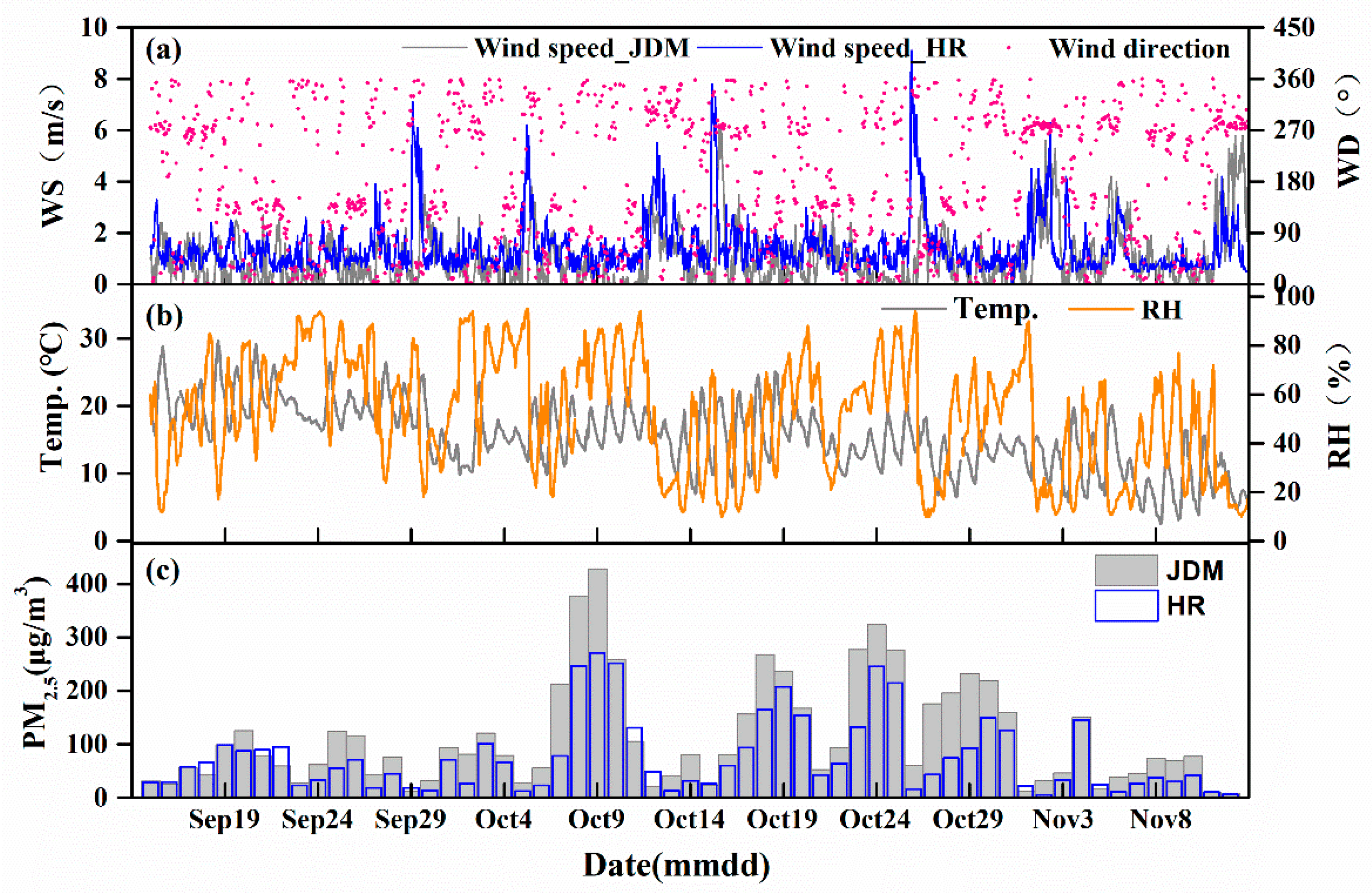
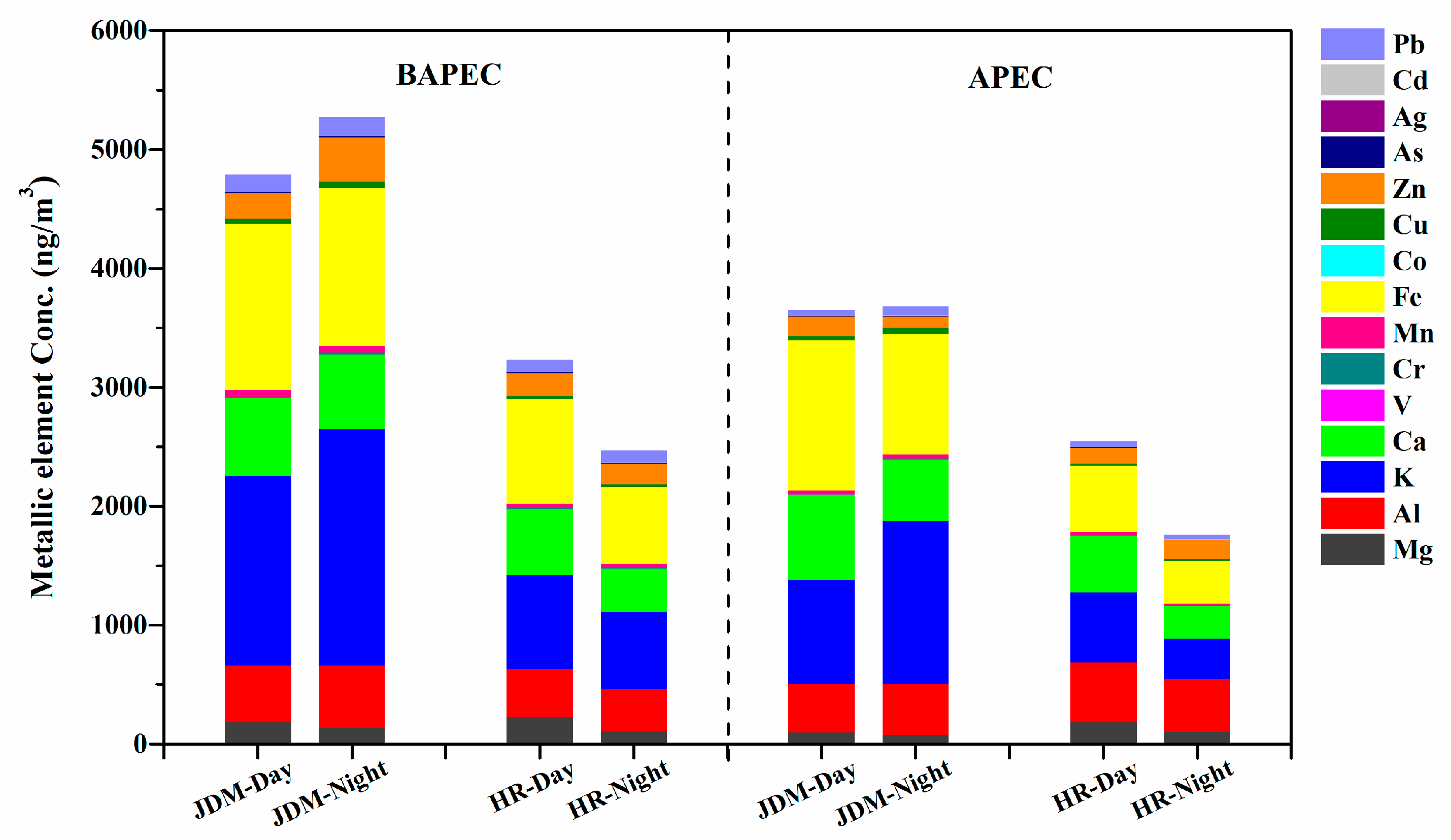
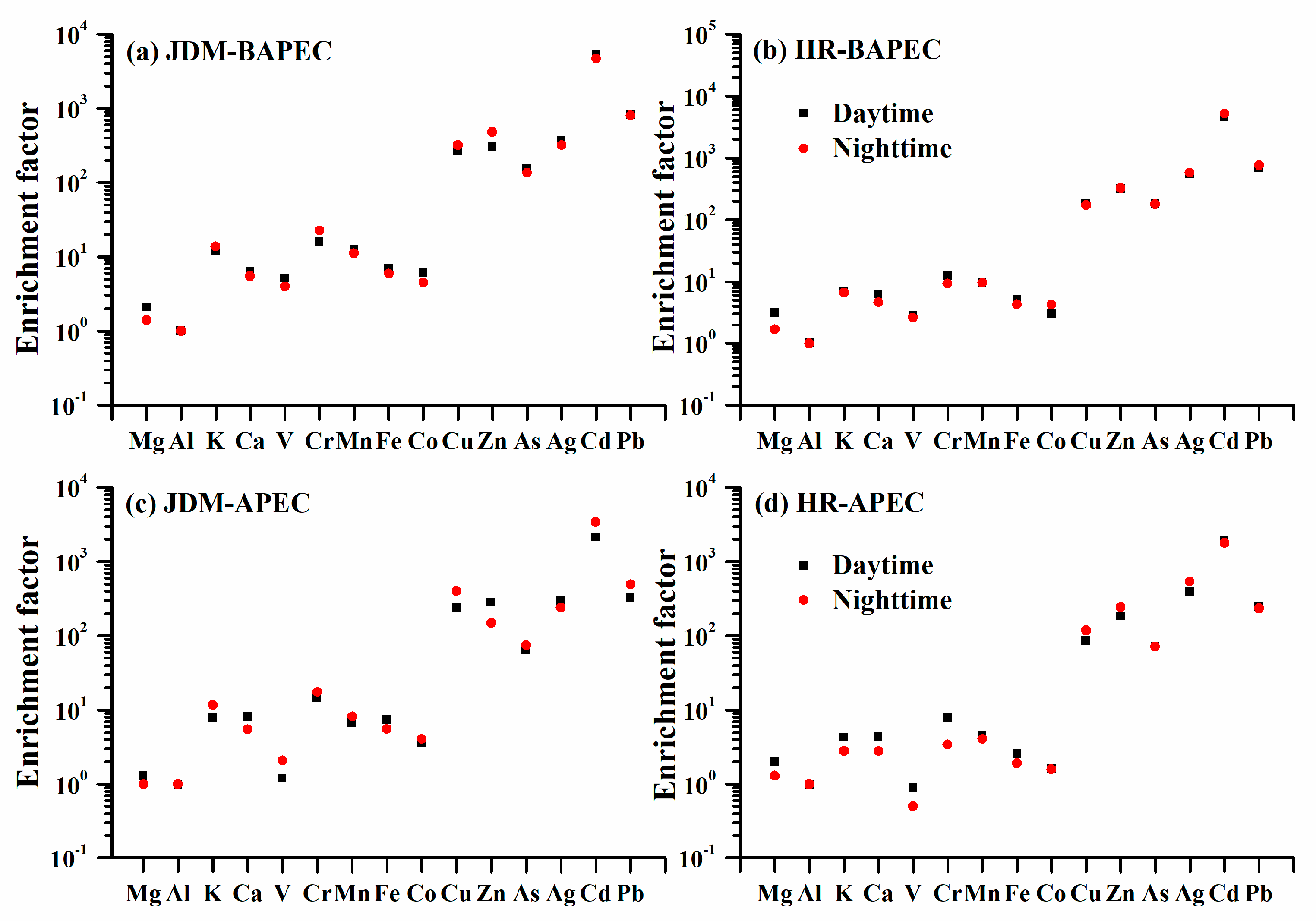
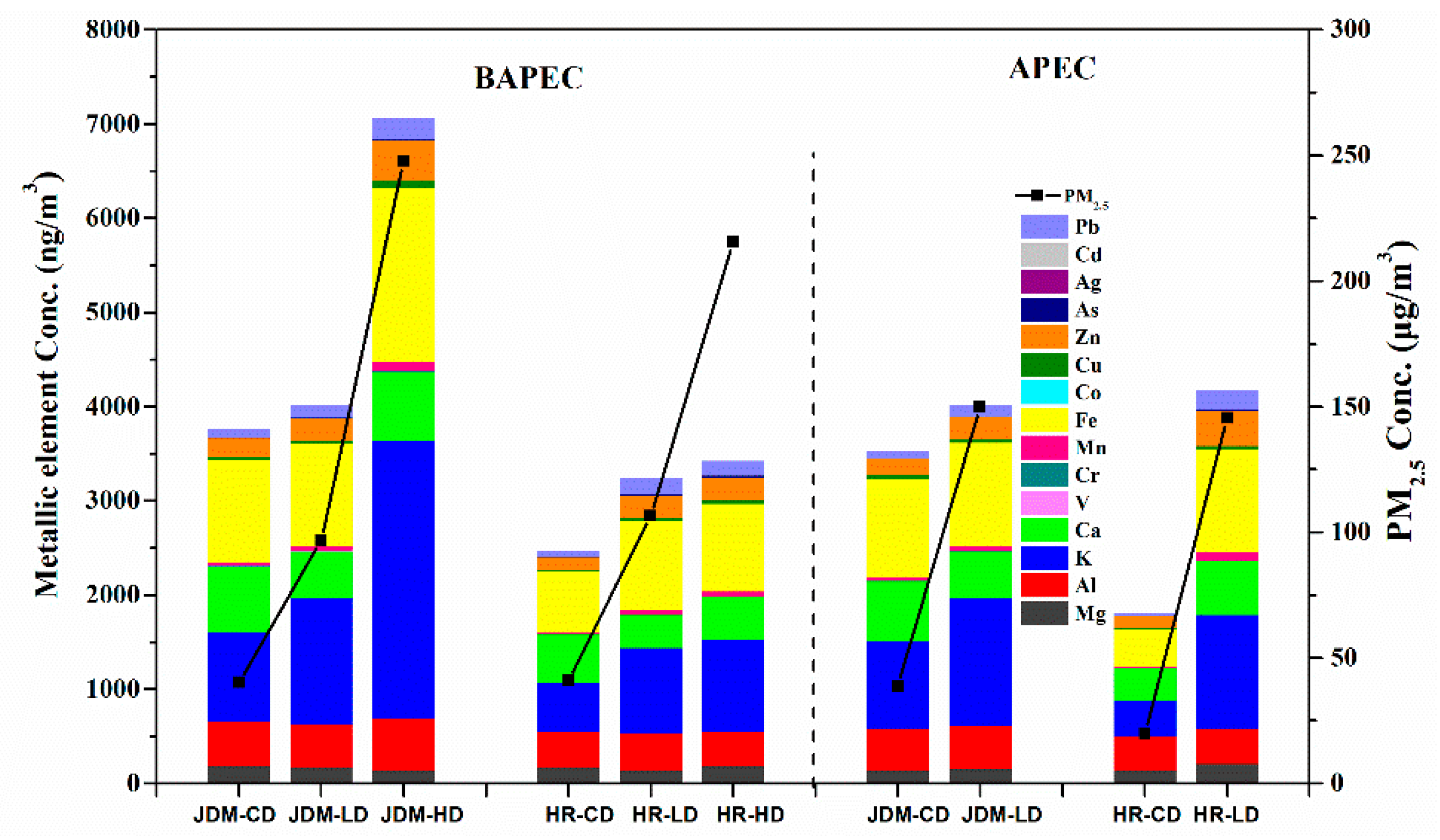
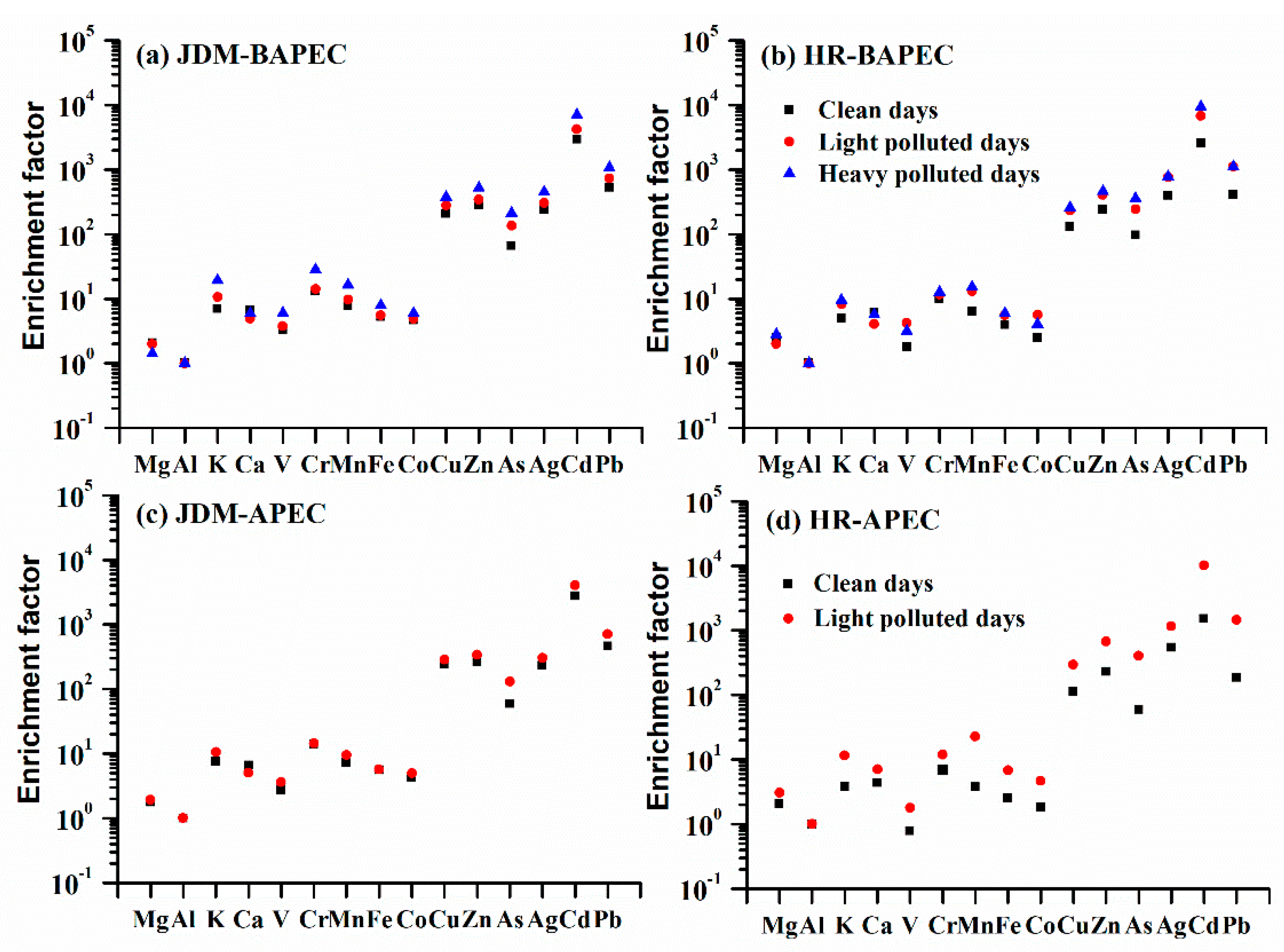
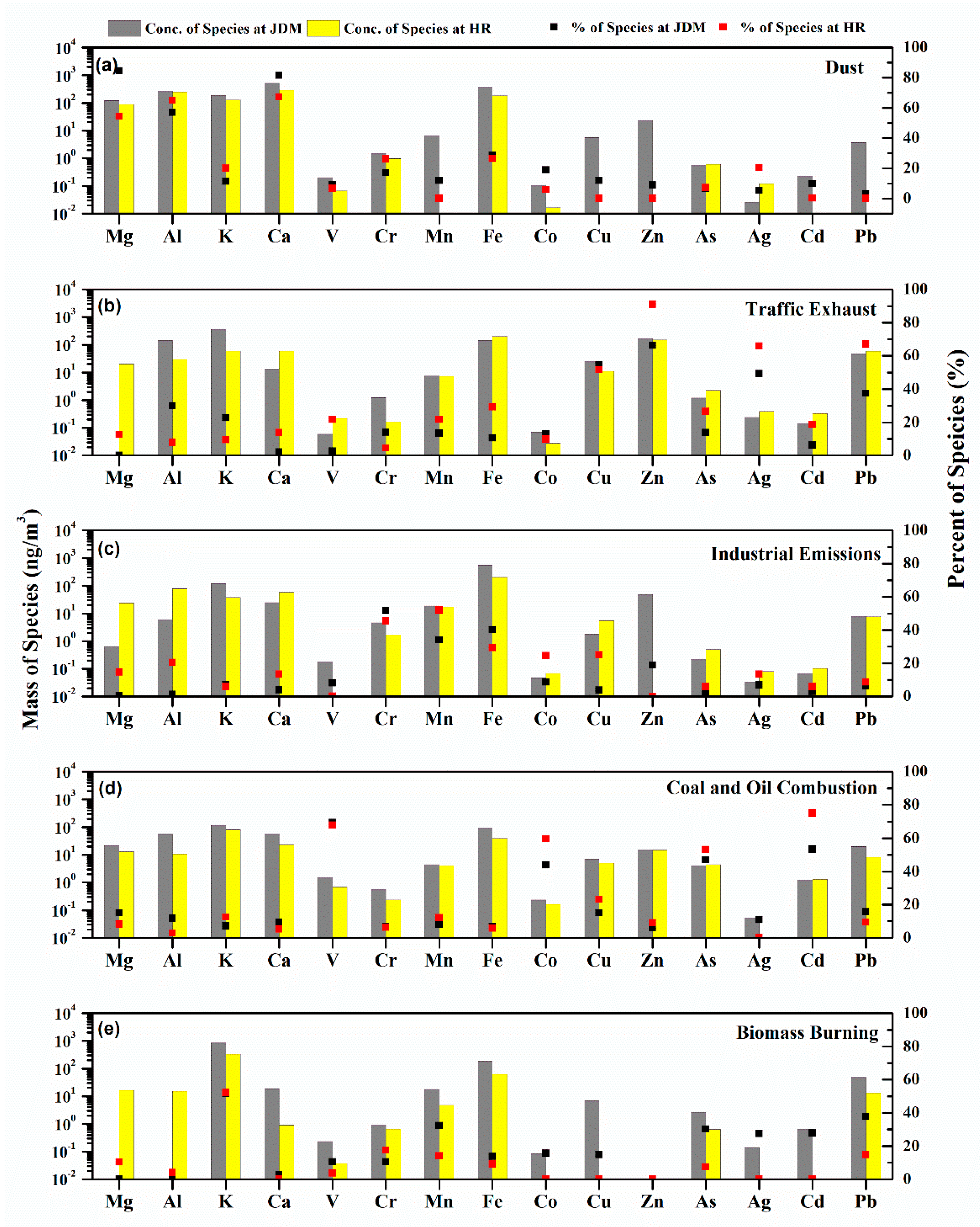
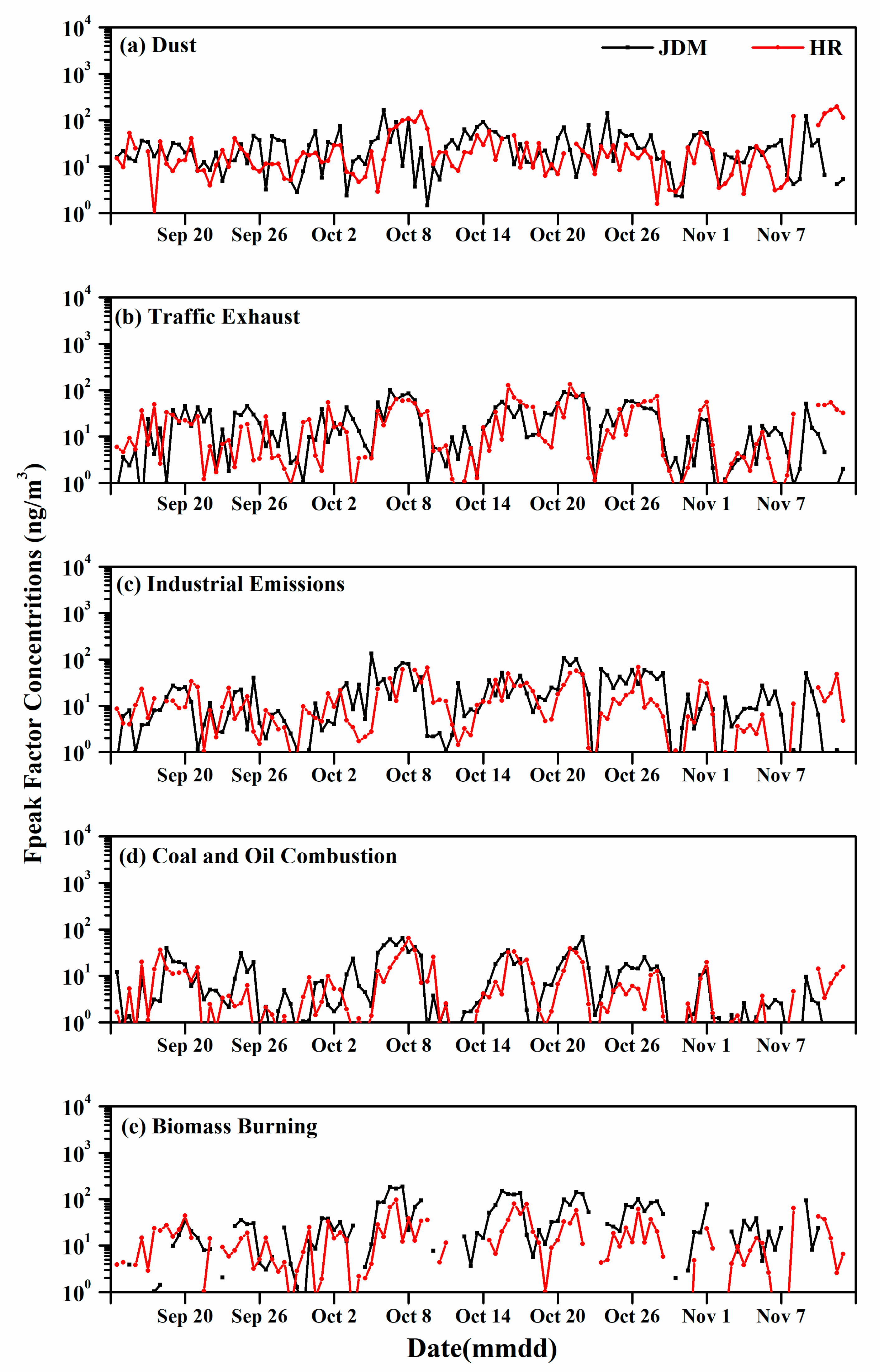
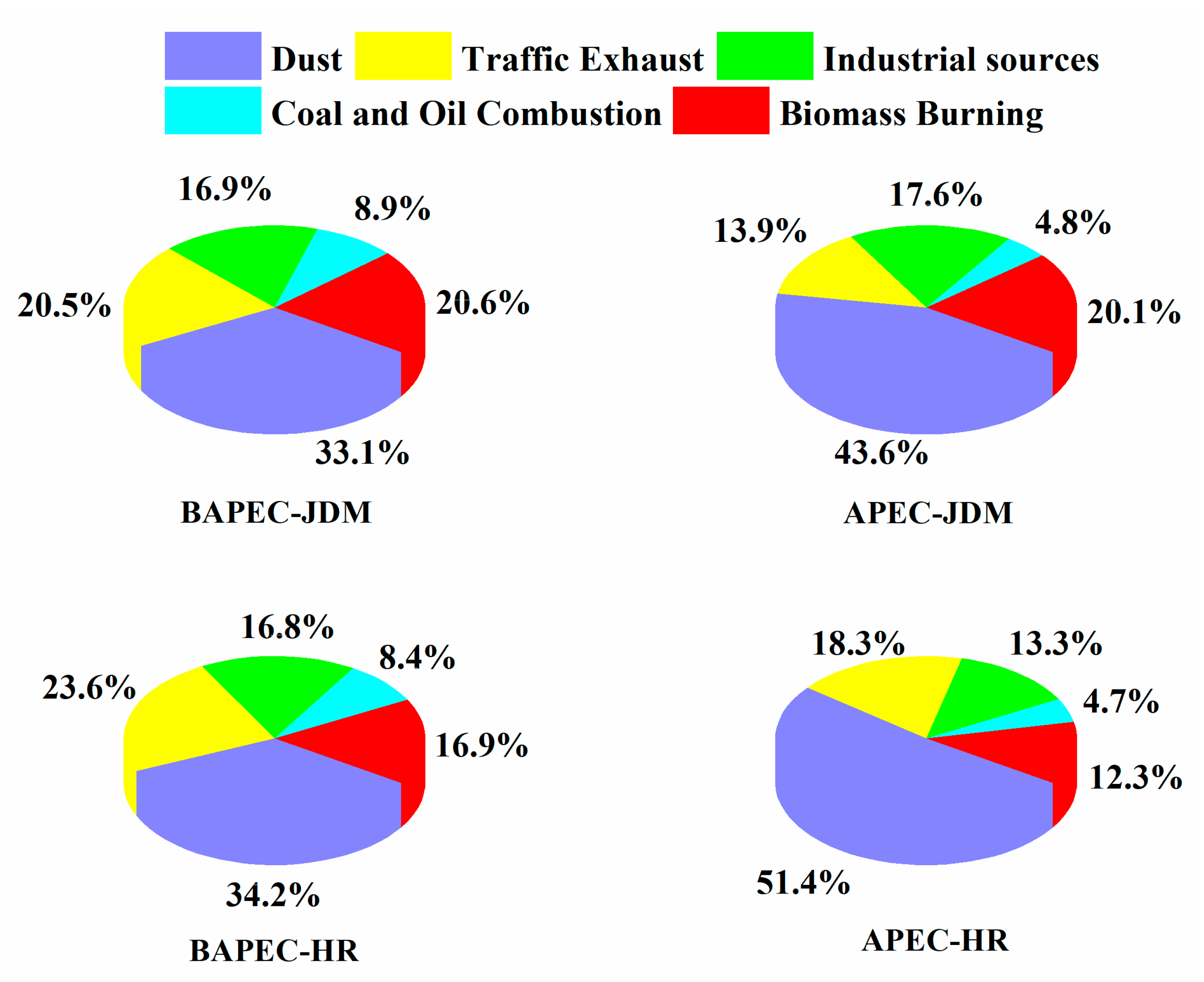
| Parameters | JDM (n = 47) | HR (n = 12) | Reduction (%) | |||
|---|---|---|---|---|---|---|
| BAPEC | APEC | BAPEC | APEC | JDM | HR | |
| PM2.5 (μg/m3) | 127.6 | 48.4 | 87.7 | 33.1 | 62.1 * | 62.3 * |
| Days of PM2.5 exceeding 75 μg/m3 | 30 | 2 | 20 | 1 | 93.3 | 95.0 |
| Exceeding Rate (%) | 63.8 | 16.7 | 42.6 | 8.3 | 73.8 | 80.5 |
| Temperature (℃) | 16.8 | 10.1 | 14.3 | 6.9 | 39.9 ** | 21.7 ** |
| Relative Humidity (%) | 56.3 | 34.1 | 69.5 | 43.9 | 39.4 ** | 36.8 ** |
| Wind Speed (m/s) | 0.82 | 1.58 | 1.44 | 1.36 | −92.7 ** | 5.6 |
| BAPEC (n = 47) | APEC (n = 12) | Reduction (%) b | ||||||
|---|---|---|---|---|---|---|---|---|
| ng/m3 | JDM | HR | Diff. (%) a | JDM | HR | Diff. (%) a | JDM | HR |
| Mg | 160.7 | 167.6 | −4.3 | 88.3 | 142.6 | −61.5 * | 45.1 ** | 14.9 |
| Al | 501 | 383.1 | 23.5 **c | 416.2 | 365.2 | 12.3 | 16.9 | 4.7 * |
| K | 1789.9 | 718.6 | 59.9 ** | 1125.3 | 460.3 | 59.1 ** | 37.1 * | 35.9 * |
| Ca | 641.9 | 456.3 | 28.9 ** | 616.5 | 369.9 | 40.0 ** | 4.0 | 18.9 |
| V | 2.6 | 1.2 | 53.8 ** | 0.76 | 0.36 | 52.6 ** | 70.8 ** | 70.0 ** |
| Cr | 9.5 | 4.0 | 57.9 ** | 6.5 | 2.6 | 60.0 ** | 31.6 | 35.0 ** |
| Mn | 59.3 | 37.4 | 36.9 ** | 31.3 | 20.6 | 34.2 | 47.2 ** | 44.9 ** |
| Fe | 1360.9 | 766.6 | 43.7 ** | 1139.1 | 455.4 | 60.0 ** | 16.3 | 40.6 ** |
| Co | 0.59 | 0.31 | 47.5 ** | 0.36 | 0.17 | 52.8 ** | 39.0 * | 45.2 |
| Cu | 49.8 | 23.1 | 53.6 ** | 45.2 | 16.3 | 63.9 ** | 9.2 | 29.4 |
| Zn | 291.8 | 180.7 | 38.1 ** | 130.1 | 146.8 | −12.8 | 55.4 ** | 18.8 |
| As | 10.0 | 9.5 | 5.0 | 4.0 | 4.7 | −17.5 | 60.0 ** | 50.5 * |
| Ag | 0.53 | 0.67 | −26.4 * | 0.35 | 0.67 | −91.4 ** | 40.0 * | 0.0 |
| Cd | 2.6 | 2.0 | 23.1 * | 1.2 | 0.9 | 25.0 | 53.8 ** | 55.0 * |
| Pb | 147.1 | 99.9 | 32.1 ** | 62.5 | 41.1 | 34.2 | 57.5 ** | 58.9 ** |
| Sources | JDM | HR | ||||
|---|---|---|---|---|---|---|
| BAPEC | APEC | Reduction (%) | BAPEC | APEC | Reduction (%) | |
| Dust (ng/m3) | 162.0 | 148.1 | −8.6 | 95.5 | 122.7 | 28.5 |
| Traffic Exhaust (ng/m3) | 100.2 | 47.3 | −52.8 | 65.8 | 43.6 | −33.7 |
| Industrial Emissions (ng/m3) | 83.0 | 59.9 | −27.9 | 46.8 | 31.6 | −32.4 |
| Coal and Oil Combustion (ng/m3) | 43.7 | 16.1 | −63.1 | 23.5 | 11.3 | −52.0 |
| Biomass Burning (ng/m3) | 101.0 | 68.4 | −32.2 | 47.3 | 29.5 | −37.7 |
© 2019 by the authors. Licensee MDPI, Basel, Switzerland. This article is an open access article distributed under the terms and conditions of the Creative Commons Attribution (CC BY) license (http://creativecommons.org/licenses/by/4.0/).
Share and Cite
Li, M.; Liu, Z.; Chen, J.; Huang, X.; Liu, J.; Xie, Y.; Hu, B.; Xu, Z.; Zhang, Y.; Wang, Y. Characteristics and Source Apportionment of Metallic Elements in PM2.5 at Urban and Suburban Sites in Beijing: Implication of Emission Reduction. Atmosphere 2019, 10, 105. https://doi.org/10.3390/atmos10030105
Li M, Liu Z, Chen J, Huang X, Liu J, Xie Y, Hu B, Xu Z, Zhang Y, Wang Y. Characteristics and Source Apportionment of Metallic Elements in PM2.5 at Urban and Suburban Sites in Beijing: Implication of Emission Reduction. Atmosphere. 2019; 10(3):105. https://doi.org/10.3390/atmos10030105
Chicago/Turabian StyleLi, Miaoling, Zirui Liu, Jing Chen, Xiaojuan Huang, Jingyun Liu, Yuzhu Xie, Bo Hu, Zhongjun Xu, Yuanxun Zhang, and Yuesi Wang. 2019. "Characteristics and Source Apportionment of Metallic Elements in PM2.5 at Urban and Suburban Sites in Beijing: Implication of Emission Reduction" Atmosphere 10, no. 3: 105. https://doi.org/10.3390/atmos10030105
APA StyleLi, M., Liu, Z., Chen, J., Huang, X., Liu, J., Xie, Y., Hu, B., Xu, Z., Zhang, Y., & Wang, Y. (2019). Characteristics and Source Apportionment of Metallic Elements in PM2.5 at Urban and Suburban Sites in Beijing: Implication of Emission Reduction. Atmosphere, 10(3), 105. https://doi.org/10.3390/atmos10030105






